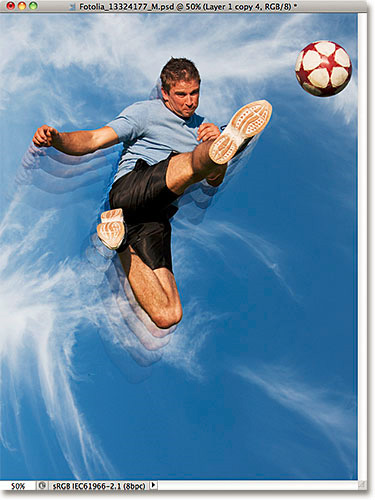How to use Photoshop CS5 - Part 27: Create a Motion effect on any object
TipsMake.com - In the next part of the tutorial series on Photoshop, we will present some basic operations to create Motion based on multiple layers of the object, along with Blend mode and Custom Opacity.

Photo source: Fotolia
And this is the final result after you've successfully completed the tutorial:

The first thing to do is to select the main object to apply in the image using tools such as Lasso Tool, Quick Selection Tool, Pen Tool . In this example, we use the Quick Selection Tool. from the main control panel:
Select the Quick Selection Tool and hover to select parts of the main object (here is the athlete image). Depending on each photo, textures and colors, use the tool as appropriate and as accurately as possible:
Then, select the Layer menu > New> Layer via Copy , or press the shortcut Ctrl + J (Windows) / Command + J (Mac):
If you look at the image, we will see nothing else, but Photoshop has created a new copy of the currently selected object on a layer, and automatically renames it to Layer 1 above the original Layer:
Then continue to create a new copy layer with the same operation. At this point, we will have 2 copy layers as shown below:
To continue, we choose Layer 1:
Use the Move Tool or press the shortcut V:
Then, move the main object in the direction of creating the Motion effect. Specific example as shown below:
Change the Blend Mode to the Layer window from Normal to Soft Light:
As a result, we will have a blurry image of the main object as follows:
Still select Move Tool , press and hold Alt (Windows) or Option (Mac) , then click on the inside of the image and move in the same direction with a little further distance:
After looking at the Layer panel, we will see 3 copy layers of the main object displayed. The next thing to do is to change the Opacity of these layers accordingly (about 65% ):
Next result at this step:
Depending on your photos and specific needs, repeat the above actions until you get the best results possible. And note that the Opacity of the following layers must always be smaller than the previous layer:
And this is the result of us in this test:
Very simple and easy, with just a few basic steps, we have created a desired work with a quite strange effect and high efficiency. Good luck!
You should read it
- Some eye-catching tips for using Adobe Photoshop
- How to use Photoshop CS5 - Part 28: Create bubbles in the image
- How to use Photoshop CS5 - Part 25: Remove automatic background images with Photoshop Action
- How to use Photoshop CS5 - Part 14: Create motion effects
- How to use Photoshop CS5 - Part 13: Create a reflection effect from the water
- How to use Photoshop CS5 - Part 18: Create nested photo effects
- How to use Photoshop CS5 - Part 17: Batch image processing with Photoshop Actions
- Stop Motion art rekindles in Vietnam
- How to use Photoshop CS5 - Part 23: Create artwork
- A Beginner's Guide to Adobe After Effects
- 15 common problems in Photoshop and basic remedies
- Instructions for using Photoshop for newbies
